Input interpretation

CO carbon monoxide + O_3 ozone ⟶ CO_2 carbon dioxide
Balanced equation
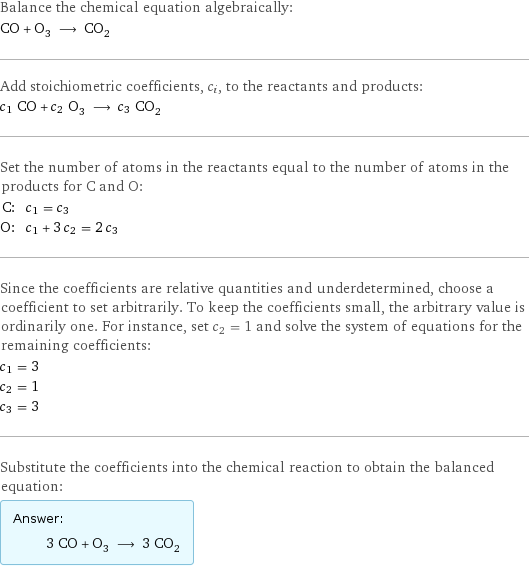
Balance the chemical equation algebraically: CO + O_3 ⟶ CO_2 Add stoichiometric coefficients, c_i, to the reactants and products: c_1 CO + c_2 O_3 ⟶ c_3 CO_2 Set the number of atoms in the reactants equal to the number of atoms in the products for C and O: C: | c_1 = c_3 O: | c_1 + 3 c_2 = 2 c_3 Since the coefficients are relative quantities and underdetermined, choose a coefficient to set arbitrarily. To keep the coefficients small, the arbitrary value is ordinarily one. For instance, set c_2 = 1 and solve the system of equations for the remaining coefficients: c_1 = 3 c_2 = 1 c_3 = 3 Substitute the coefficients into the chemical reaction to obtain the balanced equation: Answer: | | 3 CO + O_3 ⟶ 3 CO_2
Structures

+ ⟶
Names

carbon monoxide + ozone ⟶ carbon dioxide
Reaction thermodynamics
Enthalpy
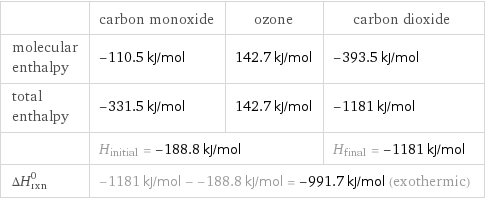
| carbon monoxide | ozone | carbon dioxide molecular enthalpy | -110.5 kJ/mol | 142.7 kJ/mol | -393.5 kJ/mol total enthalpy | -331.5 kJ/mol | 142.7 kJ/mol | -1181 kJ/mol | H_initial = -188.8 kJ/mol | | H_final = -1181 kJ/mol ΔH_rxn^0 | -1181 kJ/mol - -188.8 kJ/mol = -991.7 kJ/mol (exothermic) | |
Gibbs free energy
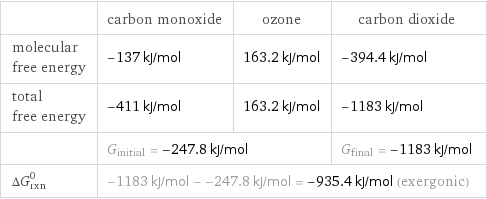
| carbon monoxide | ozone | carbon dioxide molecular free energy | -137 kJ/mol | 163.2 kJ/mol | -394.4 kJ/mol total free energy | -411 kJ/mol | 163.2 kJ/mol | -1183 kJ/mol | G_initial = -247.8 kJ/mol | | G_final = -1183 kJ/mol ΔG_rxn^0 | -1183 kJ/mol - -247.8 kJ/mol = -935.4 kJ/mol (exergonic) | |
Entropy
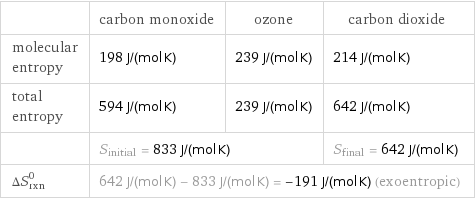
| carbon monoxide | ozone | carbon dioxide molecular entropy | 198 J/(mol K) | 239 J/(mol K) | 214 J/(mol K) total entropy | 594 J/(mol K) | 239 J/(mol K) | 642 J/(mol K) | S_initial = 833 J/(mol K) | | S_final = 642 J/(mol K) ΔS_rxn^0 | 642 J/(mol K) - 833 J/(mol K) = -191 J/(mol K) (exoentropic) | |
Equilibrium constant
![Construct the equilibrium constant, K, expression for: CO + O_3 ⟶ CO_2 Plan: • Balance the chemical equation. • Determine the stoichiometric numbers. • Assemble the activity expression for each chemical species. • Use the activity expressions to build the equilibrium constant expression. Write the balanced chemical equation: 3 CO + O_3 ⟶ 3 CO_2 Assign stoichiometric numbers, ν_i, using the stoichiometric coefficients, c_i, from the balanced chemical equation in the following manner: ν_i = -c_i for reactants and ν_i = c_i for products: chemical species | c_i | ν_i CO | 3 | -3 O_3 | 1 | -1 CO_2 | 3 | 3 Assemble the activity expressions accounting for the state of matter and ν_i: chemical species | c_i | ν_i | activity expression CO | 3 | -3 | ([CO])^(-3) O_3 | 1 | -1 | ([O3])^(-1) CO_2 | 3 | 3 | ([CO2])^3 The equilibrium constant symbol in the concentration basis is: K_c Mulitply the activity expressions to arrive at the K_c expression: Answer: | | K_c = ([CO])^(-3) ([O3])^(-1) ([CO2])^3 = ([CO2])^3/(([CO])^3 [O3])](../image_source/7da8e96e4d671a79d2dd0b010f2e1ee9.png)
Construct the equilibrium constant, K, expression for: CO + O_3 ⟶ CO_2 Plan: • Balance the chemical equation. • Determine the stoichiometric numbers. • Assemble the activity expression for each chemical species. • Use the activity expressions to build the equilibrium constant expression. Write the balanced chemical equation: 3 CO + O_3 ⟶ 3 CO_2 Assign stoichiometric numbers, ν_i, using the stoichiometric coefficients, c_i, from the balanced chemical equation in the following manner: ν_i = -c_i for reactants and ν_i = c_i for products: chemical species | c_i | ν_i CO | 3 | -3 O_3 | 1 | -1 CO_2 | 3 | 3 Assemble the activity expressions accounting for the state of matter and ν_i: chemical species | c_i | ν_i | activity expression CO | 3 | -3 | ([CO])^(-3) O_3 | 1 | -1 | ([O3])^(-1) CO_2 | 3 | 3 | ([CO2])^3 The equilibrium constant symbol in the concentration basis is: K_c Mulitply the activity expressions to arrive at the K_c expression: Answer: | | K_c = ([CO])^(-3) ([O3])^(-1) ([CO2])^3 = ([CO2])^3/(([CO])^3 [O3])
Rate of reaction
![Construct the rate of reaction expression for: CO + O_3 ⟶ CO_2 Plan: • Balance the chemical equation. • Determine the stoichiometric numbers. • Assemble the rate term for each chemical species. • Write the rate of reaction expression. Write the balanced chemical equation: 3 CO + O_3 ⟶ 3 CO_2 Assign stoichiometric numbers, ν_i, using the stoichiometric coefficients, c_i, from the balanced chemical equation in the following manner: ν_i = -c_i for reactants and ν_i = c_i for products: chemical species | c_i | ν_i CO | 3 | -3 O_3 | 1 | -1 CO_2 | 3 | 3 The rate term for each chemical species, B_i, is 1/ν_i(Δ[B_i])/(Δt) where [B_i] is the amount concentration and t is time: chemical species | c_i | ν_i | rate term CO | 3 | -3 | -1/3 (Δ[CO])/(Δt) O_3 | 1 | -1 | -(Δ[O3])/(Δt) CO_2 | 3 | 3 | 1/3 (Δ[CO2])/(Δt) (for infinitesimal rate of change, replace Δ with d) Set the rate terms equal to each other to arrive at the rate expression: Answer: | | rate = -1/3 (Δ[CO])/(Δt) = -(Δ[O3])/(Δt) = 1/3 (Δ[CO2])/(Δt) (assuming constant volume and no accumulation of intermediates or side products)](../image_source/9c825671a1871ea5749637c8634aca15.png)
Construct the rate of reaction expression for: CO + O_3 ⟶ CO_2 Plan: • Balance the chemical equation. • Determine the stoichiometric numbers. • Assemble the rate term for each chemical species. • Write the rate of reaction expression. Write the balanced chemical equation: 3 CO + O_3 ⟶ 3 CO_2 Assign stoichiometric numbers, ν_i, using the stoichiometric coefficients, c_i, from the balanced chemical equation in the following manner: ν_i = -c_i for reactants and ν_i = c_i for products: chemical species | c_i | ν_i CO | 3 | -3 O_3 | 1 | -1 CO_2 | 3 | 3 The rate term for each chemical species, B_i, is 1/ν_i(Δ[B_i])/(Δt) where [B_i] is the amount concentration and t is time: chemical species | c_i | ν_i | rate term CO | 3 | -3 | -1/3 (Δ[CO])/(Δt) O_3 | 1 | -1 | -(Δ[O3])/(Δt) CO_2 | 3 | 3 | 1/3 (Δ[CO2])/(Δt) (for infinitesimal rate of change, replace Δ with d) Set the rate terms equal to each other to arrive at the rate expression: Answer: | | rate = -1/3 (Δ[CO])/(Δt) = -(Δ[O3])/(Δt) = 1/3 (Δ[CO2])/(Δt) (assuming constant volume and no accumulation of intermediates or side products)
Chemical names and formulas

| carbon monoxide | ozone | carbon dioxide formula | CO | O_3 | CO_2 name | carbon monoxide | ozone | carbon dioxide
Substance properties
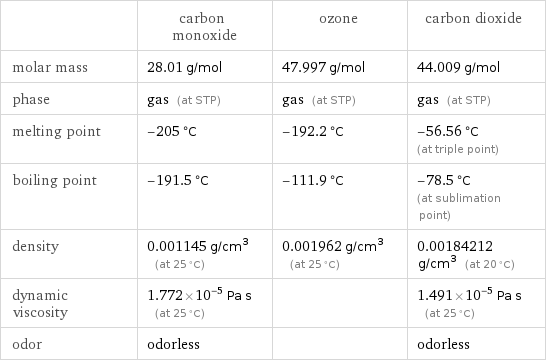
| carbon monoxide | ozone | carbon dioxide molar mass | 28.01 g/mol | 47.997 g/mol | 44.009 g/mol phase | gas (at STP) | gas (at STP) | gas (at STP) melting point | -205 °C | -192.2 °C | -56.56 °C (at triple point) boiling point | -191.5 °C | -111.9 °C | -78.5 °C (at sublimation point) density | 0.001145 g/cm^3 (at 25 °C) | 0.001962 g/cm^3 (at 25 °C) | 0.00184212 g/cm^3 (at 20 °C) dynamic viscosity | 1.772×10^-5 Pa s (at 25 °C) | | 1.491×10^-5 Pa s (at 25 °C) odor | odorless | | odorless
Units
